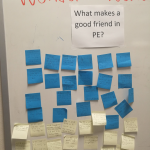I’ll just say it: I resent writing objectives.
For those of you who may not teach, I offer a brief primer.
-
Teachers are required to teach to the standards.
-
Teachers generally plan units which target specific standards.
-
Within each daily lesson during the unit, teachers write objectives of what students will learn and do to help them build toward the standard.
-
The objectives are the smaller chunks of learning that the teacher determines to be necessary to reach the standard.
-
Teachers use assessment to determine student growth on the objectives and, ultimately, the standard.
This is all solidly based in research over the years that shows that when teachers can articulate what they want students to achieve, and when students can explain what they are learning, the learning improves. I don’t have this research at my fingertips, but names such as Robert Marzano and Madeline Hunter come to mind as two of many respected educational researchers who have influenced my practice.
So, back to my rage. I have taught high school English in four districts over 19 years, and the following represents an overly simplified, biased and probably incomplete timeline of my journey through the professional development I have received learning to write objectives:
1995-2000: Have a plan. Do the plan. Make sure the plan helps students stay engaged and learn something helpful.
2001-3: Write an objective on the board so that students (but especially administrators visiting my classroom) can easily determine what the goal is for the day. It’s okay if it takes 2-3 days to reach that objective. The objective should include the learning and an observable outcome.
2004-2008: Performance assessments, or benchmarks, are created for each standard. The objective for the day should lead into the performance assessment should be written on the board for students and observers. The objective should include: The learning, the observable outcome, the conditions, and the level of proficiency. You should have a rubric developed by you or within your PLC or department that defines proficiency and can be used to track student progress over many opportunities to practice the learning. (Marzano, Wiggins, etc.)
2009-2011: To accommodate language learners, there should be both a language objective and a content objective. Also, the objectives should be divided into three tiers to engage learners at different levels. (Structured English Immersion)
2009-2012: Everything I do in class must be aligned to that darn objective. So if I have multiple objectives, such as an assignment that targets more than one standard, I’d better get those up on the board. If I have a 90 minute block with multiple strands happening at the same time, better make sure my objectives for all are posted. (Madeline Hunter, Essential Elements of Instruction*)
2012-2014: In my written lesson plans, which I must hand in weekly, I need to include one main objective. It’s okay if certain small things we do do not relate to that objective, because that’s life in the classroom where multiple things are happening all the time. Then, last year the term “behavioral objective” was being tossed about again, but I was slightly too embarrassed to ask for a reminder of what that means.
2014-2015: In addition to writing an objective in my lesson plans, I am to make sure I also rewrite it as a Learning Target, which is a chunk of learning that is accomplished and assessed that specific day. The learning target should be written from the student’s point of view and should include the learning, the Depth of Knowledge level, and the assessment. Also, identify Levels of Engagement for each activity. Learning Targets are things that are learned and achieved each day.
The speed of these cycles of change is mind-boggling. I can hardly imagine that any of the districts or schools involved really gave any of these initiatives time to take hold before they moved on to the next big initiative.
In addition, I can hardly imagine that very many of these shifts have really refined my ability to teach, or my students’ experiences learning in my class.
In addition, English class cannot, and usually should not, be broken down into a series of daily chunks. For some skill sets it helps; for others it does not, such as Sustained Silent Reading and processes such as writing and revising. These are ongoing developmental processes which are not always linear and chunkable, but also supported by research and, hello, common sense and my 19 years of experience. I could go on for weeks about this in the context of a language arts class, but maybe that’s my next blog.
Constantly obsessing over writing my objectives also limits the feeling of freedom I need to have to make adjustments as the week goes on. I spend all my time writing lessons for the following week to meet a specific format instead of analyzing where my students are right now, today, in the work they turned in and in class. Obsessing over how to write objectives limits my freedom to use technology innovatively because of the level of unpredictability that is inherent in trying out new tech tools. Perhaps most importantly, I believe it is possible that it limits my students because although we are definitely headed somewhere together, how am I supposed to predict what each of them will take away from a lesson on a daily basis?
Here’s an example of an objective dilemma from my lesson for today about a nonfiction reading on Utopia, which we will be studying in our next unit: If we read about Utopias and only focus on, say, use of parenthetical commentary and quotations to achieve the author’s purpose for her audience… what is lost in terms of theme? If I only read in terms of theme, then I lose an opportunity to analyze a great little example of a writer using her style to reach her audience. I worry that the analytical chunking of knowledge and narrowness of the definition of an objective actually discourages the kind of holistic thinking about writing, literature and humanity that, frankly, makes kids want to become English teachers. Or at least lifelong learners and readers.
And yet, in classroom observations and in conferences about my lesson plans, the focus is on the objective, the chunking of time and student engagement, and the assessment.
So where does that leave me?
If I allow it to, it leaves me in a world that pulls me away from what I believe to be worthwhile goals. Can I meet the requirements of my professional development and lesson plans while also staying true to my vision of how an English class should be run? Probably, but I waste an awful lot of time and mental energy doing it, time that could be used better.









Comments 6
Your timeline is eye-opening and I’ve lived it, too. For years I’ve said that my best lesson plan template is a blank sheet of paper. I definitely think I should have ends in mind that align with the district’s curriculum, but as much as we hear in PD that we should measure achievement and not compliance, our masters seem pretty set on making sure we comply – at a cost to instructio
Yes. Noncompliance is not an option.
I wish that instead of daily lessons, I could fill out that DNA spiral of the Architecture of Accomplished Teaching.
Love your ideas about the DNA spiral Amethyst! Now if we could only get some more NBCTs…..maybe we can turn this big ship in a different direction…
I often find myself wishing that I spent as much time in meetings talking about students, as we do objectives. “Were the objectives aligned? Did they have all the required components?” etc. I worry that we get so focused on the writing on the board that we forget why it’s even there. To support student learning. To help every child to be successful with the learning.
Excellent post. Part of the problem is that from the very beginning standards-driven instruction has been based on research that’s somewhere between shaky and non-existent. And when there has been decent research, it’s been done in subjects quite different from ELA and then transposed to ELA after the fact. People like it because it’s a way to manage teachers and their actions, not because it produces better learning.
What you describe above doesn’t look so much like change as it does refinement and improvement in teaching practice–and over a good length of time for that matter. I don’t see a bunch of different initiatives–I see one initiative gradually scaffolded toward a high level of application. Aside from the “have a plan, do the plan” phase, everything else looks like gradual improvement of the instructional use of objectives.
You mention “how am I supposed to predict what each of them will take away” from a given lesson: I don’t think you are. I think you’re supposed to identify what you hope they will take away, then as they engage, having an objective doesn’t in and of itself prevent them from learning other things.